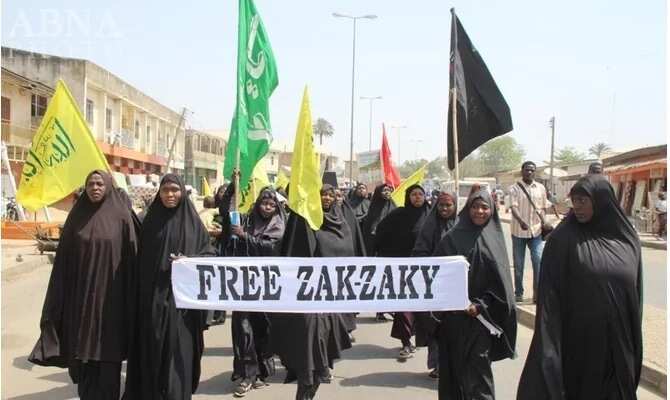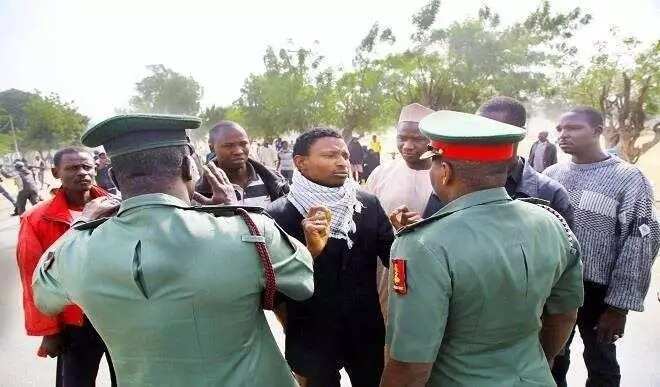Army, Shiites clash: The untold narrative
Editor’s note: Many people were feared dead after a bloody clash between armed soldiers and the Islamic Movement of Nigeria in Zaria, Kaduna state on December 12-13, 2015. Johnson Obioha gives fresh details on the incident and shares his views on the development.

The narrative of the encounter between the Nigerian Army and Islamic Movement of Nigeria (IMN), popularly referred to as Shiites Islamic Sect, cannot be more intriguing, especially with the startling revelation by Kaduna state government of the existence of a mass grave. It was a revelation that sent shocking waves across Nigeria and beyond.
Not only did the disclosure that 347 Nigerians were killed and casually dumped in a mass grave sent shivers down the spine, it also changed the dynamics of the inquest behind the deadly clash.
According to the director-general of Kaduna state Interfaith Agency, Mr. Namadi Musa, it took the officials about six hours to complete the alleged mass burial of suspected member of the IMN, in a single grave.
There is no doubt Musa's testimony at the public hearing of the Judicial Commission of Inquiry, was quite damning; it is however, rather curious that the disclosure came from the government, which until then, was seen as the bitter enemy of the Shiites.
While the effort of the state government officials to expose what looks like extra-judicial killings seems noble, but a closer look at the emerging narrative will expose the intentions of those orchestrating the plots and sub-plots of the narrative.
The unveiling of the behind the scenes of that fateful night by Musa, seems to be a well-crafted sequence, created to extricate some vested individuals from the mess and with the ultimate aim of elevating the Nigerian Army to the podium of the aggressor.
READ ALSO: Shiites are worse than Boko Haram - El-Zakzaky's brother
Again, the plot seems to have worked as the Amnesty International (AI), which has been critical of the Nigerian military human rights records, have now been given the legitimate weapon with which to clobber the armed services.
Consequently, having fed into their long standing narrative without waiting for the final verdict of the Commission, the AI joined other similar rights groups around the world in demanding investigation into the bloody affair.
They hurriedly latched onto it, stressing that the “horrific revelation by the state government that hundreds of Shiites were gunned down and dumped in mass graves is an important first step to bringing all those suspected of criminal responsibility for this atrocity to face trial.”
According to the rights group “it is now imperative that the mass grave sites are protected in order that a full independent forensic investigation can begin.”
Nevertheless, a cursory look into the evolving politics of the Inquiry will expose what looks like a well calculated attempt to put the military on the spot in order to mask the culpability of the other actors in the messy saga. One would have been tempted to predict that the ultimate aim of the unfolding events is to make the Chief of Army Staff (COAS), Lt-Gen. Tukur Buratai, the scapegoat, should those threatening to extend it to the International Criminal Court (ICC), get their wish.
Notwithstanding the motive behind the likely pre-emptive move by the schemers, the timing and manner of the 360-degree turnaround by the state government, has raised a lot of suspicion about their intentions. The testimony has raised a lot of questions that are begging for answers: who were the perpetrators of this evil act? Was the Army solely behind the alleged killings? Were there other interested parties behind the scene? Was there an incitement, a plot and plan by some powerful forces other than the Shiites and Army, who exploited the situation to cause mayhem and exact maximum revenge? How culpable were the IMN leadership in creating the deadly confrontation?

One of the national daily in its recent editorial, "expressed serious misgivings about the manner the Nigerian authorities have handled this tragedy". The popular medium also admonished that while many fine points of the bloody incident were still vague, it was necessary that all sides, especially the federal and Kaduna State governments as well as the Directorate of State Service (DSS), refrained from actions that could only compound the situation.
It went further to pose several questions begging for answers: "Who exactly were these people whose corpses were brought from the army barracks and how did they die, especially in such a large number? Were the identities of the dead bodies ascertained before they were given a mass burial? If they were buried on December 15, as revealed by the Kaduna State officials, and the clash between the Shiites and the army occurred December 12 -13, at what point did these people die? To add, were the alleged mass grave real and secured, as the Army recently debunked the satellite imagery of "mass grave" claimed by AI in its report have been exposed to be fake?
It could therefore, be concluded here that only the untold narrative would shed more light to the sad reality.
How it All Started and Nigerian Army's Restraint
Prior to the deadly confrontation on December 12, in Zaria, most Nigerians including the Governor of Kaduna State, Mallam Nasir El-Rufai, have expressed misgivings about the manner with which the IMN disturb the public peace through their religious processions. At the height of it, El-Rufai was alleged to have been pelted with sachets of water popularly called ‘pure water’ by the group members during one of his visits to Zaria. Consequently, there was no doubt that many were frustrated including the members of the Nigerian Armed Forces who have had clashes with the Sect in the past.
However, this reached the heights of sheer stupidity and suicidal intent, when the leadership of IMN encouraged their followers to block moving convoy of Buratai for several hours, despite the fact that the entourage were coming from a war-zone and trigger ready for self-defence. It was therefore, to the credit of the Army to have exercised unusual restraint from using maximum force to break the hostile surrounding of their number one officer and symbol of national security. The video showing how some of the Senior Officers, especially the Director of Army Public Relations (DAPR), Col. Sani Usman, came down to appeal to the recalcitrant Shiites, even at the risk of his own life and that of his boss, was evident enough of an armed force cautious to kill innocent citizens.
READ ALSO: Fallen soldiers will be given national honours - Buratai
This commendable but risky approach to save the day was even criticised by many security experts who noted that there is nowhere in the world, even in civilised climes that citizens would hold the convoy of a military chief, hostage for almost an hour.
"It is not done anywhere in the world, particularly during war times. It could have amounted to cowardice and ultimate dismissal or court-martial had the COAS as the head of the Nigerian Army, representative of the President and Commander in Chief, bowed to the intimidation of the group," one of the principal actors explained.
The Deadly Confrontations: Who Ordered What? Who sent the bulldozers? Who armed the Shiites?
It was on record that the Nigerian Army was able to break the Shiites siege and free the COAS convoy with minimal force and collateral damage but what transpired afterwards to trigger the alleged killings and mass burial is still sketchy.
There have also been several conspiracy theories, especially with the one postulating that Kaduna State government being wary of the daring act of the IMN ordered that their headquarters be demolished. It was also disclosed that the Governor had in response to the earlier incident, met with the top security officers in the state to draw up next line of actions with the ultimate aim of disarming the religious sect members who were alleged to have been trained and armed for eventual confrontation with the Nigerian State.
"It was a joint operation of all the security forces in the state and not just the Nigerian Army," said one of the intelligent personnel, adding "even the bulldozers used to demolish the Shiite settlement were supplied by the Kaduna State government".
"But the question members of the public and the media should be asking is who armed the Shiites. Who trained them in warfare? Where did they get their arms and for what purpose," a concerned officer asked.
Nevertheless, the question still remains who carried out the acts; was it the Army, other security agents or outside forces who exploited the situation? Who ordered the later operation that led to the killings and how culpable were the Shiite leaders for resisting arrest and search of their surroundings for the purported stockpile of weapons? Answers to these questions will help outline the truth.
Who's Behind the AI Overbearing Interference
There is no doubt that the AI since the incidence has openly shown its bias against the military, which is becoming legendary. While one who values human lives must commend their efforts to ensure that rights of the citizenry are protected and preserved but such important global agency must not be allowed to be hijacked by some individuals in the country who has personal agenda to project.
Having observed the unfolding dynamics of the tragic event, one cannot help but agree with the Nigerian Army in this instance when it berated AI's recent report on the discovery, for being too hasty, partial, judgemental and subjective.
READ ALSO: Nigerian soldiers burned Shiites alive in Zaria - Amnesty
In deed, the recent AI report created doubt on the level of impartiality and rightly so, accused them of having a premeditated agenda for not waiting for the constituted Judicial Commission of Inquiry set up by the Kaduna State government and National Human Rights Commission (NHRC) to submit its report.
Consequently, the seeming attempt by some forces to make the Army and Buratai, the ultimate scapegoat of this whole saga, is a pointer to a more sinister plot. This raises the questions: were the state government officials under pressure from some vested interests to change the dynamics of the event? And could there be a link between the whole drama and some powerful forces who were not happy at the determination of the Buratai led Army to exterminate Boko Haram from the North-East?
Ultimately, what most Nigerians and the rest of the world would want is for anyone or group found liable for the violence, including the IMN leadership, to be brought to justice. However, care must be taken to ensure that the process will not be 'spinned' to punish the innocent in order to achieve a grand plan of derailing the counter-terrorism efforts and as well as covering the truth behind the death of Nigerian citizens.
This article expresses the authors’ opinion only. The views and opinions expressed here do not necessarily represent those of Legit.ng or its editors.
Source: Legit.ng
